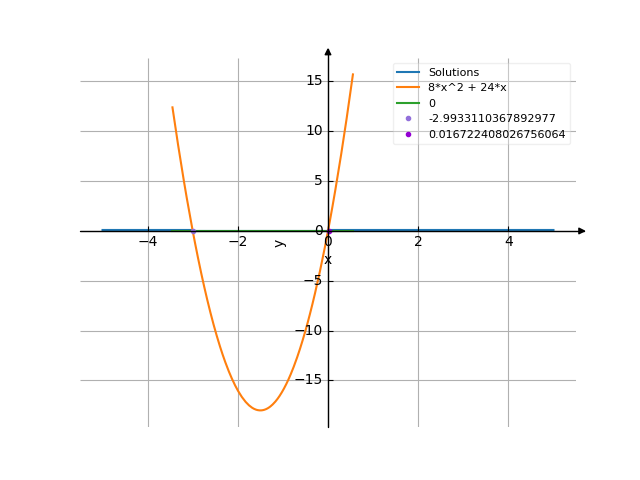8x²+24x>=0 inequation
The solution
Detail solution
Given the inequality:
$$8 x^{2} + 24 x \geq 0$$
To solve this inequality, we must first solve the corresponding equation:
$$8 x^{2} + 24 x = 0$$
Solve:
This equation is of the form
A quadratic equation can be solved
using the discriminant.
The roots of the quadratic equation:
$$x_{1} = \frac{\sqrt{D} - b}{2 a}$$
$$x_{2} = \frac{- \sqrt{D} - b}{2 a}$$
where D = b^2 - 4*a*c - it is the discriminant.
Because
$$a = 8$$
$$b = 24$$
$$c = 0$$
, then
Because D > 0, then the equation has two roots.
or
$$x_{1} = 0$$
Simplify
$$x_{2} = -3$$
Simplify
$$x_{1} = 0$$
$$x_{2} = -3$$
$$x_{1} = 0$$
$$x_{2} = -3$$
This roots
$$x_{2} = -3$$
$$x_{1} = 0$$
is the points with change the sign of the inequality expression.
First define with the sign to the leftmost point:
$$x_{0} \leq x_{2}$$
For example, let's take the point
$$x_{0} = x_{2} - \frac{1}{10}$$
=
$$-3 - \frac{1}{10}$$
=
$$- \frac{31}{10}$$
substitute to the expression
$$8 x^{2} + 24 x \geq 0$$
$$24 \left(- \frac{31}{10}\right) + 8 \left(- \frac{31}{10}\right)^{2} \geq 0$$
one of the solutions of our inequality is:
$$x \leq -3$$
Other solutions will get with the changeover to the next point
etc.
The answer:
$$x \leq -3$$
$$x \geq 0$$
$$8 x^{2} + 24 x \geq 0$$
To solve this inequality, we must first solve the corresponding equation:
$$8 x^{2} + 24 x = 0$$
Solve:
This equation is of the form
a*x^2 + b*x + c = 0
A quadratic equation can be solved
using the discriminant.
The roots of the quadratic equation:
$$x_{1} = \frac{\sqrt{D} - b}{2 a}$$
$$x_{2} = \frac{- \sqrt{D} - b}{2 a}$$
where D = b^2 - 4*a*c - it is the discriminant.
Because
$$a = 8$$
$$b = 24$$
$$c = 0$$
, then
D = b^2 - 4 * a * c =
(24)^2 - 4 * (8) * (0) = 576
Because D > 0, then the equation has two roots.
x1 = (-b + sqrt(D)) / (2*a)
x2 = (-b - sqrt(D)) / (2*a)
or
$$x_{1} = 0$$
Simplify
$$x_{2} = -3$$
Simplify
$$x_{1} = 0$$
$$x_{2} = -3$$
$$x_{1} = 0$$
$$x_{2} = -3$$
This roots
$$x_{2} = -3$$
$$x_{1} = 0$$
is the points with change the sign of the inequality expression.
First define with the sign to the leftmost point:
$$x_{0} \leq x_{2}$$
For example, let's take the point
$$x_{0} = x_{2} - \frac{1}{10}$$
=
$$-3 - \frac{1}{10}$$
=
$$- \frac{31}{10}$$
substitute to the expression
$$8 x^{2} + 24 x \geq 0$$
$$24 \left(- \frac{31}{10}\right) + 8 \left(- \frac{31}{10}\right)^{2} \geq 0$$
62 -- >= 0 25
one of the solutions of our inequality is:
$$x \leq -3$$
_____ _____
\ /
-------•-------•-------
x_2 x_1Other solutions will get with the changeover to the next point
etc.
The answer:
$$x \leq -3$$
$$x \geq 0$$
Solving inequality on a graph
Rapid solution
[src]
Or(And(0 <= x, x < oo), And(x <= -3, -oo < x))
$$\left(0 \leq x \wedge x < \infty\right) \vee \left(x \leq -3 \wedge -\infty < x\right)$$
((0 <= x)∧(x < oo))∨((x <= -3)∧(-oo < x))
Rapid solution 2
[src]
(-oo, -3] U [0, oo)
$$x\ in\ \left(-\infty, -3\right] \cup \left[0, \infty\right)$$
x in Union(Interval(-oo, -3), Interval(0, oo))
The graph


![Solve the inequality 8x²+24x>=0 (8x² plus 24x greater than or equal to 0) - Specify the set of solutions of the inequality in detail step by step. [THERE'S THE ANSWER!] 8x²+24x>=0](/media/krcore-image-pods/176/hash/inequation/7/43/29c3bec83fcd98317b37164a04076.png)
 8x²+24x>=0
8x²+24x>=0